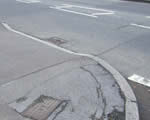 Go to main content
Go to main content
Archive Website of the UK government
Please note that this website has a UK government accesskeys system.
Main menu
Page menu
Home and community

Applying for a dropped kerb

A crossing across a public footpath or verge that allows your vehicle to gain access to your property from the highway is known as a 'dropped kerb' or vehicle crossing. Find out how to make an application for a dropped kerb or crossing.
Making an application for a dropped kerb
How to apply
Dropped kerbs and vehicle crossings
You can contact your local council to apply for a dropped kerb. Your local council will usually carry out the work and charge you for the costs. Some councils may allow you to use a private contractor from an approved list of companies or require the contractor to meet strict legal requirements. Where two property owners share a driveway, and both wish to share a double width crossing, one occupier should act on behalf of both parties.
The link on the right will allow you to enter details of where you live and then take you to your local council's website where you can find out more.
What to consider before installing a dropped kerb
There are a number of things to consider before installing a dropped kerb. In some cases planning permission is required, for example, if a dropped kerb links to a trunk road or a classified road.
Listed building consent may be required if the dropped kerb relates to a listed building.
Approval is also required for the work to install the dropped kerb from the relevant highways authority (usually the county council).
You should discuss your intention to install a dropped kerb with your local council before starting any work.
Dropped kerb applications - what the council will consider
Parking within your property
If planning permission is required, your application for a dropped kerb will not be approved unless:
- you can provide a suitable parking area within your property
- there is enough space around this parking area for pedestrian access
If your property is more than eight metres wide these conditions may not apply. If these criteria are not met, approval may still be given, subject to a site inspection by a highway inspector. The highway inspector's decision is final.
No part of a vehicle parked within your property may project onto or over the highway.
Types of vehicles permitted
A domestic vehicle crossing may only be used by a private light goods or similar vehicle. It may not be used by heavy goods vehicles or mechanical equipment. If a delivery, such as a skip, is made to the property and it damages the crossing, any repairs will be the occupiers' responsibility.
Types of driveway
In general, you will not need planning permission if a new or replacement driveway of any size uses ‘permeable surfacing’. Permeable surfaces allow liquids to pass through them. An example of a permeable surface would be gravel.
An impermeable driveway, such as one made of certain types of tarmac prevents liquids from passing through. You will also not generally need planning permission for a new/replacement ‘impermeable’ driveway of any size, as long as rainwater drains to a naturally permeable area. However, the naturally permeable area must be within your own land.
New or replacement driveways over five square metres that are impermeable, or do not direct rainwater to a naturally permeable area, will need planning permission.
This applies to the area of land between the front wall of the house and the highway in England.
Council powers to remove unauthorised dropped kerbs and crossings
Your local council, acting as the highway authority, is responsible for maintaining footpaths. Your council has the power to close or remove a vehicle crossing or dropped kerb if it has been installed without permission.
The crossing or kerb must:
- be certified if it is built over a public footpath
- be strong enough to take the weight of the vehicle
- not create a hazard for pedestrians and other footpath and road users
 Facebook
Facebook Twitter
Twitter StumbleUpon
StumbleUpon Delicious
Delicious Reddit
Reddit